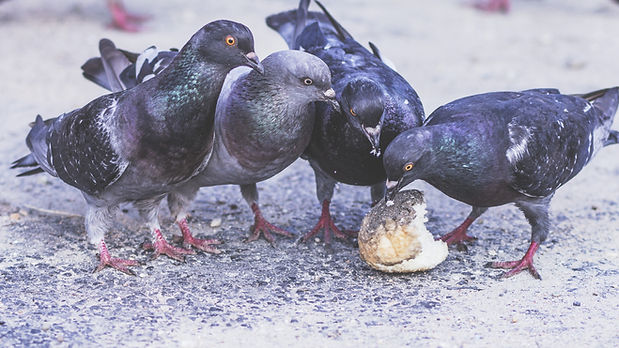Myths, Misconceptions and Facts
Before we dive into the fascinating world of pigeons—uncovering myths, misconceptions, and surprising facts—why not test your knowledge first? Pigeons are often misunderstood, but their history, intelligence, and unique abilities might surprise you. This quick quiz will challenge what you think you know about these remarkable birds. Are they really dirty city pests? Can they recognize human faces? Let’s find out - Press on the "?" to begin!
<div id="CDccSKLYgnySoztJgXsPMS1647000" ></div><script data-qz-key="CDccSKLYgnySoztJgXsPMS1647000" src="https://api.quizell.com/js/qzembed.js"></script>
Now that you've tested your knowledge, it's time to delve deeper into the truth about these pigeon myths, misconceptions, and remarkable facts.
Pigeons have proven themselves considerably more extraordinary than many people realise, saving lives during combat and exceeding technology in navigation.
In the following section, we'll dispel some of the most common misunderstandings about pigeons, investigate their scientific talents, and discover how they've influenced human history. Whether you passed the quiz or learnt anything new, prepare to be shocked by what pigeons are truly capable of!
Misconceptions
Many people have negative perceptions of pigeons, believing them to be unclean, unintelligent, or even a nuisance. However, scientific data do not support these unfavourable preconceptions; rather, they are grounded in myths. Here we will investigate some of the most common pigeon myths and expose their intriguing foundations.


Misconception #1: Pigeons Are Dirty and Spread Disease
A prevalent misconception regarding pigeons is that they are unclean, disease-laden creatures that present a significant health threat to humans. Although pigeons are capable of harbouring bacteria and parasites, the likelihood of disease transmission to humans remains exceedingly low, comparable to that associated with other avian species.
📌 Scientific research indicates that the transmission of zoonotic diseases from pigeons to humans is highly unlikely under normal circumstances. The predominant infections associated with pigeons, such as histoplasmosis and cryptococcosis, are primarily airborne and usually result from contact with substantial accumulations of desiccated droppings in enclosed spaces, rather than from direct contact with the birds (Haag-Wackernagel & Moch, 2004). Subsequent studies demonstrate that domesticated animals, including dogs and cats, pose a greater health risk to humans than pigeons (Dobeic et al., 2011).
📖 Scientific Insight: A study in the European Journal of Wildlife Research suggests that while pigeons can carry specific pathogens, the actual risk to humans is often exaggerated, mainly because direct transmission routes are lacking (Haag-Wackernagel & Moch, 2004).
Misconception #2: Pigeons Are Unintelligent
A prominent misconception is that pigeons lack intelligence and possess minimal cognitive abilities. Pigeons are, in fact, remarkably intelligent creatures, demonstrating abilities in problem-solving, pattern recognition, and the discernment of various artistic styles.
📌 Pigeons have been extensively studied in cognitive research, exhibiting abilities comparable to those of some primates. They can recognise their reflections in mirrors, identify different human faces, and differentiate between written language and nonsensical text (Scarf et al., 2016). Their ability to retain and categorise numerous images demonstrates an intelligence that exceeds typical assumptions.
📖 Scientific Insight: A study published in CBE—Life Sciences Education indicates that pigeons can be trained in word recognition, object categorisation, and the understanding of abstract concepts, highlighting their status as among the most intelligent bird species (Wasserman et al., 2012).


Misconception #3: Pigeons Are Just Urban Pests
It is a common misconception that pigeons exclusively flourish in urban environments due to their dependence on human food waste; however, this belief is not entirely accurate.
📌Pigeons originated in steep cliffs and coastal regions, which accounts for their preference for nesting on elevated structures and in crevices. Their adaptation to urban environments illustrates their resilience rather than dependence on humans. Research indicates that urban pigeons prefer grains and seeds to abandoned human food when given a choice (Jerolmack, 2007).
📖 Scientific Insight: A study in the European Journal of Wildlife Research indicates that the survival of urban pigeons primarily results from their ability to adapt to new food sources and utilise city structures for nesting (Haag-Wackernagel, 2008).
Misconception #4: Pigeons Have Poor Navigation Skills
Some people believe that pigeons roam aimlessly throughout cities, but they are actually amongst the most adept navigators in the animal kingdom.
📌Pigeons employ various sensory mechanisms for navigation, such as detecting the Earth's magnetic field, utilising the sun's position, and recognising infrasound (Gagliardo, 2013). They are capable of travelling distances of up to 1,000 miles while maintaining a remarkable ability to navigate back home accurately.
📖 Scientific Insight: Research in Animal Behaviour indicates that pigeons utilise specialised neurones to perceive Earth's magnetic field, effectively providing them with an innate GPS system (Gagliardo, 2013).


Misconception #5: Feeding Pigeons Bread Is Good for Them
Many people enjoy feeding pigeons, especially with bread, but this is actually harmful to their health.
📌 Bread is deficient in essential nutrients, resulting in malnutrition and health complications, including Angel Wing Syndrome, which manifests as deformities in wings. Pigeons necessitate a balanced diet that includes grains, seeds, and minerals to maintain optimal health (Jerolmack, 2007).
📖 Scientific Insight: Research in Wildlife Biology indicates that inadequate diets in urban pigeons result in compromised immune systems and shorter lifespans when contrasted with those that have access to more natural food sources (Jerolmack, 2007).

Pigeon Myths: Separating Fact from Fiction
Aside from misunderstandings about pigeons being unclean or dumb, these birds are the subject of several myths and legends, some of which are based on history, folklore, and even pseudoscience. Myths, unlike common misconceptions, are typically the result of overblown stories, cultural beliefs, or outmoded scientific theories that have stood the test of time.
In this part, we'll look at some of the oddest, most fascinating, and frequently held beliefs about pigeons—and reveal the truth behind them.
Myth #1: Pigeons Can Explode from Eating Rice
Myth: If pigeons consume uncooked rice, the grains enlarge in their bellies and cause them to explode.
📌 This myth has been used to discourage the practice of throwing rice at weddings, yet it lacks scientific support. Birds, particularly pigeons, can safely digest rice in a manner similar to other grains. Many wild pigeons consume rice in agricultural fields without adverse effects (Jerolmack, 2007).
📖 Scientific Insight: Avian stomachs exhibit high efficiency in digesting grains, particularly rice, suggesting that enlargement does not adversely affect them (Dobeic et al., 2011).

Myth #2: Pigeons Were Used as Spies with Cameras Strapped to Them
Myth: Pigeons were commonly utilised in espionage, equipped with tiny cameras to take aerial images of enemy targets.
📌 This myth contains elements of truth. Pigeons were employed for reconnaissance during both World Wars I and II. Some were outfitted with small automated cameras affixed to their bodies, which recorded aerial images of opposing positions. Although these spy pigeons existed, their usage was not as extensive as depicted in popular culture (Wilson, 2021).
📖 Scientific Insight: Declassified documents indicate that the CIA conducted experiments involving pigeon photography during the Cold War. The project was ultimately discontinued in favour of satellite monitoring (Pearson, 2011).

Myth #3: Pigeons and Doves Are Different Species
Myth: Pigeons and doves are two distinct species, with doves being more graceful and pigeons being urban scavengers.
📌Pigeons and doves are classified within the same avian family, Columbidae. The differentiation in terminology is primarily cultural; "dove" typically denotes smaller, white-feathered species, while "pigeon" pertains to larger avian species, especially those prevalent in urban environments. The rock pigeon (Columba livia) is classified as a "dove," similar to other species within the family (Scarf et al., 2016).
📖 Scientific Insight: Pigeons and doves are genetically the same group of birds, with hardly any discernible differentiation (Wasserman et al., 2012).

Myth #4: Pigeons Are Just City Birds and Can’t Survive in the Wild
Myth: Pigeons are entirely reliant on humans and would become extinct without city life.
📌Pigeons are derived from wild rock doves that inhabited cliffs, mountains, and coastal areas prior to urbanisation. Their inherent adaptability enables them to flourish in urban environments, while they are also capable of surviving in the wild under appropriate conditions. Feral pigeons persist in nesting on rocky cliffs located outside metropolitan areas (Haag-Wackernagel, 2008).
📖 Scientific Insight: According to Gagliardo (2013), urban pigeons have the same survival instincts as their wild counterparts and may thrive in both urban and natural settings.

Myth #5: Pigeons Were Used to Carry Messages in Ancient Egypt
Myth: Pigeons were used to carry messages dating back as far as Ancient Egypt.
📌 Pigeons have served as messengers for millennia, with their widespread use occurring notably during the Persian and Roman periods. Egyptians retained and nurtured pigeons primarily for religious purposes, sustenance, and possibly early communication experiments (Jerolmack, 2007).
📖 Scientific Insight: While Egyptian archaeology confirms large-scale pigeon breeding, historical messaging records are more prevalent in Persian, Greek, and Roman sources (Wilson, 2021).

Myth #6: Pigeons Always Mate for Life
Myth: Pigeons form lifetime bonds with their mates and never seek out new partners.
📌Pigeons exhibit social monogamy and form strong pair bonds; however, they do not necessarily mate for life. A pigeon that loses its mate will seek a new partner and resume breeding activities. Additionally, although pairs stay united during breeding seasons, instances of extra-pair mating have been documented (Gagliardo, 2013).
📖 Scientific Insight: Research in Animal Behaviour confirms that pigeons show strong pair bonds, but their mating behaviour is more flexible than the myth suggests (Wasserman et al., 2012).

Myth #7: Pigeons Are a Modern Urban Problem
Myth: Pigeons only became common in cities in the last century due to overpopulation and urbanisation.
📌 Pigeons have coexisted with humans for millennia. Domestication occurred over 5,000 years ago, and these entities were historically regarded as symbols of status, communication, and food production. In recent history, individuals have increasingly regarded them as pests rather than valuable animals (Haag-Wackernagel, 2008).
📖 Scientific Insight: Archaeological findings indicate that pigeons were raised in large numbers as far back as Mesopotamian times, showing that their close relationship with humans is far from a modern issue (Dobeic et al., 2011).

Fascinating Pigeon Facts: Surprising Truths About These Incredible Birds


